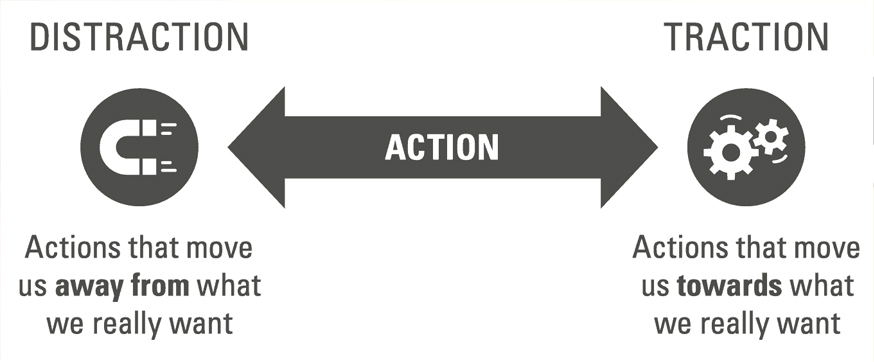Control Your Day – Or It Will Control You
In today’s hyper-connected world, staying focused on what truly matters can feel like an uphill battle. Notifications, social media, emails, and endless digital distractions constantly compete for our attention. But what if we told you that distraction isn’t about the external triggers themselves—it’s about how we respond to them?
People who excel at time management and productivity aren’t immune to distractions; they’ve simply learned how to manage them effectively. They know how to plan, prioritise, and redirect their focus when faced with competing demands. Most importantly, they understand that the secret to staying on track isn’t just about eliminating distractions—it’s about mastering the internal triggers that drive them.
Based on the insights from Nir Eyal & Julie Li’s book Indistractable, this article explores the psychology of distraction and a practical, research-backed approach to reclaiming your focus. By mastering internal triggers, you can move away from Distraction and take meaningful steps (Traction) toward what truly matters.

What Truly Motivates Us? Understanding the Root of Distraction
Why do we get distracted? According to philosopher Jeremy Bentham, human behaviour is governed by two powerful forces: pain and pleasure. However, Nir Eyal & Julie Li argue that the greatest motivator of all is the drive to relieve discomfort.
This means that distraction isn’t simply about external triggers like social media notifications or email alerts – it’s an internal struggle. Without the right strategies, we can fall into an endless loop of avoiding discomfort, leading to habits that pull us further from our goals.
Eyal & Li outline four key insights about how internal triggers influence our behaviour:
✅ Distraction starts from within – Learning to recognize the root cause of distraction is the first step to overcoming it.
✅ All motivation is a desire to escape discomfort – Every action we take, from checking our phones to snacking mindlessly, is driven by a need to relieve some form of discomfort.
✅ Anything that alleviates discomfort can become addictive – When a distraction provides temporary relief, we’re likely to repeat the behavior, creating a cycle of dependency.
✅ Self-awareness is the antidote – Identifying the internal triggers behind our distractions allows us to manage them more effectively.
If distractions steal our time, then mastering our time is about mastering discomfort management. Instead of viewing dissatisfaction as a problem, we should learn to harness it as a source of motivation and growth.
How to Manage Distractions From Within: The ACT Approach
Simply resisting distractions doesn’t work. Research suggests that suppressing urges often makes them stronger—a phenomenon known as the ironic process theory. Instead of trying to force distractions away, Eyal & Li propose a different approach: Acceptance and Commitment Theory (ACT).
ACT teaches us how to pause, observe, and reframe our internal experiences before reacting. Rather than resisting distractions, we should acknowledge them, explore their origins, and let them pass naturally.
The 10-Minute Rule: A Powerful Technique
If you feel the urge to check your phone, scroll through social media, or procrastinate, try this:
⏳ Wait 10 minutes before acting on the impulse
🔍 Observe the discomfort behind the urge
📌 Decide whether to give in after the 10 minutes
This method disrupts the automatic habit loop, allowing you to regain control over your actions.
Reimagining Internal Triggers: 4 Steps to Mastering Distraction
To gain control over distractions, Eyal & Li recommend reframing the way we experience internal triggers. Follow these four steps to manage distracting thoughts more effectively:
1. Identify the Discomfort Behind Distraction
Pause and mindfully observe what’s happening before you reach for a distraction. Are you feeling anxious? Bored? Restless? Recognizing these emotions can help you break free from automatic reactions.
2. Track Internal Triggers
Write down when, where, and why distractions occur. Logging your distractions helps you spot patterns and develop a strategy to manage them.
3. Observe Your Physical Sensations
When you’re about to get distracted, take note of any bodily sensations—fidgeting, tension, or an increased heart rate. Eyal & Li reference a powerful mindfulness technique from Bricker’s research:
🌊 Visualization Exercise:
Imagine sitting beside a gently flowing stream. Picture your distracting thoughts as leaves drifting past on the water. Let them float away without judgment or resistance. This technique helps you detach from distractions rather than fight them.
4. Beware of Liminal Moments
Liminal moments—those small transitions between tasks—are prime opportunities for distraction. Catch yourself in these moments and refocus before a minor diversion turns into a full-blown distraction spiral.
Reimagining Tasks: Making Work More Engaging
Why do some tasks feel more engaging than others? According to Eyal & Li, our perception of a task influences our level of distraction. If a task feels tedious or overwhelming, our brains will naturally seek a more pleasurable alternative.
The solution? Reframe tasks to make them more enjoyable.
💡 Find novelty – Even routine tasks can be engaging if approached with curiosity.
🎯 Set small challenges – Turn work into a game by setting personal goals.
🧠 Adopt a growth mindset – View difficult tasks as opportunities to improve rather than obstacles to avoid.
As Ian Bogost states, “Fun is the aftermath of deliberately manipulating a familiar situation in a new way.” When we consciously inject creativity and curiosity into our tasks, distractions lose their grip on us.
The Danger of Dwelling: Why Self-Compassion Matters
Eyal & Li highlight the connection between mindset, willpower, and distraction. When we dwell on past mistakes, self-blame, or feelings of failure, we become more vulnerable to distractions that offer temporary relief.
Denise Winterman’s research suggests that reducing self-blame and rumination can significantly lower the risk of anxiety and depression. Instead of criticizing yourself for losing focus, practice self-compassion:
💬 Reframe mistakes as learning opportunities
🧘 Accept that distractions are normal
🚀 Commit to refocusing rather than dwelling on setbacks
What we say to ourselves matters. The way we respond to distractions determines whether we stay stuck in a cycle of avoidance or move forward with clarity and control.
Ready to Become Indistractable?
Now that you understand the power of mastering internal triggers, the next step is to put these strategies into action. Start by identifying your distractions, reimagining challenging tasks, and practicing techniques like the 10-minute rule to regain control over your focus. By managing discomfort rather than escaping it, you can create a life where you control your attention—instead of letting distractions control you.
Strengthen Your Focus with Get Mentally Fit
At Get Mentally Fit, we help individuals and teams develop the skills needed to build deep focus and mental resilience. Whether you’re looking to improve personal productivity or foster a distraction-free culture in your workplace, we provide evidence-based tools and expert guidance to support your journey.
Take the Next Step
📩 Get in touch to discuss how we can help you or your team improve attention management and mental fitness.
🚀 Explore our Workshops to help your team stay focused and productive.
🔍 Join the Get Mentally Fit Community for more expert insights, practical strategies, and exclusive resources.
Let’s take back control—one mindful moment at a time.


